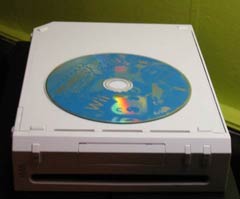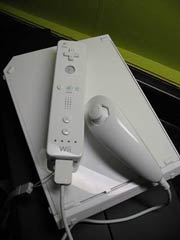You can use it as a whiteboard, you know
When you unbox the Wii, you're going to be shocked at how small the thing is. The system itself is tiny. This is a welcome change from the Xbox 360 and PS3—systems large enough to have their own measurable gravitational fields. The Wii is white and shiny, and the face is clean. We've said this about Nintendo products before, and we'll probably say it again: they almost feel like Apple products. This is design that people are going to enjoy just for its size and ease of use. Every port on the back is clearly marked, and since the system only supports 480i/p, the included composite cables aren't drastically limiting (although we do recommend the component cable for anyone who can use it).
One thing that is missing from the back is an Ethernet port. The system is currently WiFi-only; you'll need a wireless network to take your Wii online and mess with the Virtual Console. Don't have WiFi? There's two options. I discovered that the Nintendo WiFi Dongle works with the Wii, so PC users have that option. If that doesn't float your boat, Nintendo will be offering USB Ethernet support for $25, shipping in early January.

Awww, it's a little face
Rounding out the unboxing, I'll say this: Nintendo packs a good variety of stuff with the Wii: one controller and nunchuck, the stand, the sensor bar, a set of AA batteries, and a copy of Wii Sports. I love the fact that you need nothing else out of the box to start gaming: you get a game and even a set of batteries right there. It may seem silly to some, but you know that's going to save lives during Christmas...
A free GameCube in every box?
The Wii also packs a little present of its own, depending on your perspective. A small flap on the side of the system hides ports for four GameCube controllers and two memory cards. This system is perfectly backwards compatible; it uses existing controllers and memory cards, and there's nothing else to buy to play your GameCube games. This is a very nice touch, and makes the $250 price point even more attractive because you're basically getting a GameCube for free.
You're probably going to want a GameCube controller, or at least the Classic Controller accessory. The Wiimote turned on its side to play classic games is cool, but far from ergonomic. It also won't fit the bill for a number of Virtual Console games, such as Mario 64, which require either the GameCube or Classic Controller. You can pick up the classic controller for $20, or a used GameCube controller for even less.
This is your gun, your steering wheel, and your tennis racket
Before we go any farther, we need to take a good look at the hardware of the controller itself. The Wiimote feels solid, and while it's not heavy, it has a nice heft to it. The buttons all feel good, and it fits in my hand perfectly. The nunchuk controller is something of a mixed bag, as it feels light and even a little cheap, and it's slightly smaller than I expected it to be. The analog stick and two trigger buttons feel good, though. I just wish the thing had a little more beef to it.
If you have big hands you may want to try one of these before you buy, or wait for a third-party solution. Large-handed people may get a little frustrated by the diminutive controllers. The Wiimote also comes with a lanyard attached to it, and I would recommend using it because in some of the games the controller has a bad habit of flying out of your hands. There have been a number of reports and pictures of televisions and windows broken when the lanyard has snapped during a spirited game, and while it has yet to happen to us, this is certainly something to look out for.
The rumble isn't as strong as it is in other console controllers, but you can tell it's there; the tactile feedback even when navigating around menus is great. I'm not nearly as impressed with the internal speaker; it's more often tinny and annoying than anything else. It's fun in some games, but I very quickly ended up turning its volume down. If that's not enough, you can kill the sound altogether.
Now the big question: usage! The first thing that must be said is that sensor bar placement is important. If it's off-center in a significant way (more than about an inch too much left or right, in our own testing), or it if is not close to being level with the floor, you'll get erratic and irritating results. The reason for this is because the sensor bar is no real sensor bar. It actually pulses infrared light, which a camera on the Wiimote then picks up and uses alongside accelerometer measurements to gauge movement. One byproduct of this is that other sources of infrared light can interfere with the Wiimote, so keep that in mind if you're having difficulties.
One gotcha that might affect a few users is the fact that the sensor bar is wired, so you will need to keep your system near your television. This can be a pain for people with projectors or home theaters, but both extension cables and wireless sensor bars are rumored to be coming soon. The sensor bar ships with a cable that is approximately 12 feet long.
In good working conditions—and we were not able to faze our Wii by exposing it to a reasonable amount of sunlight—the controller is quite responsive, surprisingly so to many people who use it for the first time. That said, there is a slight lag on controller response with very fast movements, but you learn to compensate for it so quickly that it's not much of a problem, and during games, it's barely noticeable. The whole system is comfortable, easy to use, and feels more interesting than just another Dual Shock.
That said, the controller is all new, and the fact of the matter is that assessing how "good" it is will be a case-by-case project. Different games use the controller in different ways, some well, and some not so well. You can tilt it back and forth like a pointer. In another game, you may hold it horizontally as if you were steering a car. In another, you're sawing through bones, and in a Metroid demo we played in October, you actually reach out, grab controls in the game world, and push, twist, and pull them.
There are times when the Wiimote just doesn't work though or feels too clumsy. Take boxing in Wii Sports, for example. Even after moving the sensor bar, fiddling with the sensitivity, and an hour or so of practice, I couldn't get my character to do what I wanted; I would throw a high punch and it would show a bodyshot on the screen. I aimed low, and my guy just kind of flailed. It felt clumsy and broken to me—I simply couldn't get it to do what I wanted. Red Steel is also very twitchy, and while it does work, expect to be playing a long time before it feels comfortable. Even after playing for a while I would still have some problems aiming straight, and every now and again it was almost as if my character got locked into spinning. It seemed as if the sensor would glitch and my aim would go crazy for no reason.
All in all, I found the nunchuk + Wiimote combination to be incredibly comfortable in long playing sessions. I was able to rest my hands on either side of my legs while playing Zelda, and that wouldn't be possible with a classic controller design. It was an interesting discovery, because most of the chatter is about how the Wii makes you move, but by freeing your hands from the classic controller experience, there's actually more options for comfort in some games.




reader comments